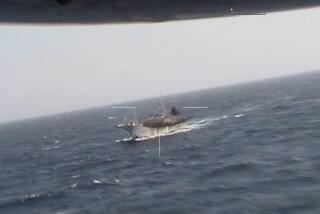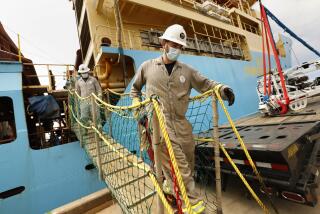A Rift Over Troubled Waters
- Share via
They are mere specks in what seems the middle of the ocean; barren chunks of land amid a flat expanse of blue.
On the surface, they’re not much to look at. But anyone who has been to Mexico’s Revillagigedo Islands will say that it is what’s beneath the surface that makes them so special.
The remote four-island archipelago, located more than 200 miles south of Baja California and 400 miles west of the mainland, is seasonal home to a stunning array of marine creatures. Giant Pacific mantas soar over the reefs with power and grace. Predatory sharks maintain a random but thorough patrol.
Divers, many of them wielding spears, have reported swimming amid schools of tuna and wahoo that seemed to have no end. Anglers, mostly aboard San Diego-based vessels, say there is no better place to catch these prized species.
But these have long been troubled waters. Over and over the mantas have been harpooned, the sharks butchered by poachers. And now, amid more of this plunder, and amid claims by spear-fishermen that sport fishermen are taking too much tuna and wahoo, these barren specs in the ocean appear to have become even more isolated.
With no advance warning, Mexico last week invalidated sportfishing permits and announced that all consumptive recreation would cease. The action was taken by the Attorney General for the Protection of the Environment, or PROFEPA, only days after a visit to the islands by the high-ranking Secretary of Government, Santiago Creel Miranda.
Creel has the law on his side--sort of. The islands have been protected since 1994, when the Revillagigedo Archipelago Biosphere Reserve was established. Commercial fishing was banned immediately within 12 miles, but sportfishing and spear fishing, with restrictions, was allowed to continue until the completion of a management plan that would spell out any such special uses.
That plan was supposed to have been completed within a year, but eight years later there still is no plan, only confusion.
Various branches of government have continued to authorize and issue permits that allow fishing beyond 547 yards (500 meters) of the islands for migratory species such as tuna and wahoo. But now the policing and enforcement branches (PROFEPA and the Secretariat of the Navy) are interpreting the law to mean that no fishing should take place unless specified in a management plan.
The issue is more complex, but basically it’s a catch-22 situation that has forced the San Diego long-range fleet to seek other options--while arguing to have this one restored.
In an article published Monday in the on-line forum www.hispanicvista.com, fleet consultant Barnard Thompson called Creel’s announcement “a huge overreaction” to a poaching incident he witnessed during his visit to the islands three weeks ago. That trip was made soon after meetings in Mexico between President Bush and Mexican President Vicente Fox, intended to improve ties between the nations.
“Mexican officials are showing a darker side that could give pause to any entrepreneur and/or developer who might have an investment interest in that country,” Thompson wrote.
San Diego’s fleet has been fishing the islands for about 30 years, exclusively targeting tuna and wahoo. Ten of its vessels are annually issued permits for a five-month season ending in late May. Only eight used the permits last season.
These are specialized trips costing $3,000 or more per person, lasting nearly two weeks. Many are shorter “fly-down, fly-back” trips, with pickups and drop-offs in Cabo San Lucas.
All told, Thompson wrote, the trips annually contribute $2.9 million directly to the Mexican economy, “to say nothing of indirect spending and benefits received by Mexico through promotions and advertising.”
Some in Mexico have contended for years that the Revillagigedo Island fishery belongs to Mexico and should not be utilized for profit by U.S. interests, despite the contributions Thompson refers to. If these sentiments influenced PROFEPA, so, too, did events that occurred during Creel’s trip.
The visit coincided with that of the environmental watchdog group Sea Watch. Those on the Sea Watch vessel, including veteran breath-hold “free divers,” encountered commercial fishermen retrieving long-line gear two miles north of San Benedicto Island, the northernmost of the four. Footage of the poachers hauling dead sharks over the rail--an estimated 250 to 350--was presented to Creel. It aired the next night on Mexican television, along with interviews with the official, who pledged more protection within the reserve.
Sea Watch founder Mike McGettigan also presented Creel with a “state of the fisheries” report citing substantial declines over the past 30 years, due mostly to commercial fishing practices but also to those of the San Diego sportfishing fleet.
The report suggested more restrictive bag limits for sport fishermen and that trolling should be banned to lessen the danger to giant mantas and whale sharks. It did not recommend the elimination of spear-fishing or sportfishing. Its findings are purely anecdotal, devoid of scientific evidence and based solely on observations of free divers and photographers.
“All I know is what I see,” said Terry Maas, a world-renowned spear fisherman from Ventura, who was with McGettigan during his meeting with Creel.
“I’ve probably been to the islands 40 times since 1983 and sharks, tuna, wahoo ... all are down by about 80%. I used to see schools of wahoo that went beyond the field of sight.”
Bob Fletcher, president of the Sportfishing Assn. of California, called the report baseless and labeled McGettigan a “loose cannon” who is doing more harm than good.
Tim Ekstrom, owner-operator of the Royal Star, said, “To base these conclusions on the observations of a handful of divers is beyond ludicrous. But even more ludicrous is that anyone would put stock in such a report.”
The per-angler bag-limit before the closure was 15 tuna and 15 wahoo per trip. “But the reality is, our boats won’t even hold that many fish,” Ekstrom said. His log book, typical of those turned in by the other seven captains, revealed an average angler catch last season of seven tuna (averaging 90-120 pounds) and six wahoo (25-40 pounds) per trip.
“These guys are taking home 700 pounds of tuna, but our impact on the fishery is nil,” Ekstrom said.
Robin Allen, director of the Inter-American Tropical Tuna Commission, said that while it’s possible that sportfishing small areas “might affect the local abundance” during a given time, “generally speaking it won’t have an impact on the fishery.”
He added that yellowfin tuna stocks in the Eastern Pacific were deemed healthy enough last year to sustain a record quota of 310,000 metric tons. Wahoo are not managed by the IATTC.
McGettigan stands by his group’s efforts, saying, “Sea Watch is against anything that depletes the biosphere’s stocks of pelagic and reef fish.” That he and many of his supporters are spear fishermen may make them look like hypocrites, but it is widely accepted that such a selective and small-scale effort has even less of an impact on the resource than sportfishing.
In any event, both of these groups have been ordered out. Which begs an important question: Who’s going to keep an eye on the poachers?
Creel may have vowed greater protection, but the remoteness of the islands and the fact that they’re so spread out makes them all but impossible to effectively patrol. “And don’t think the poachers don’t know that,” Ekstrom said.
News and Notes
* Ultra-long-range: Some captains have turned their attention even farther south to French-owned Clipperton Island, 780 miles south of Cabo San Lucas and 600 miles west of Nicaragua. Ekstrom made the journey in mid-March and his passengers enjoyed phenomenal tuna fishing, with three of the fish topping 200 pounds.
These are somewhat risky trips, though. Fishing is not always so good, the heat can be unbearable and the sharks relentless.
* In the pink: Last Saturday’s salmon opener was fair in the Ventura-Santa Barbara area, with fish to 35 pounds caught as far south as Santa Monica Bay. This week, the fish are still plentiful, but scattered and deep, with trollers using big spoons and releasable three-pound weights doing best. The fleets are hopeful that baitfish will school up along the coast, resulting in a greater concentration of salmon.
* On tap: The annual End of Trail World Championship of Cowboy Action Shooting and Wild West Jubilee is April 17-21 at Raahauge’s Ranch in Norco. Details: (714) 694-1808 or www.sassnet.com.... The Orange County Boat Show is April 18-21 at the Anaheim Convention Center. Details: www.scma.com.
Winding Up
Among competitors in the upcoming Citgo Bassmasters tour event at Lake Guntersville in Alabama is Real Andrews, who plays Lt. Taggert in “General Hospital.”
Says Andrews: “This has been a dream of mine for as long as I can remember. It might sound [like a] cliche, but I literally eat, sleep and dream fishing.”
FISH REPORT, D14
More to Read
Sign up for Essential California
The most important California stories and recommendations in your inbox every morning.
You may occasionally receive promotional content from the Los Angeles Times.










